Fatland case study

Fatland uses eye-share Workflow Invoice with solutions tailored specifically for the meat industry!
There is no doubt that people in the accounting department have much more time than they had before and can spend their time on other issues that are critical to the daily operation.
Roar Malmin, CFO at Fatland
Implementing the eye-share Workflow Invoice module has freed up significant time for the accounting department, allowing them to focus on critical daily operations. For Fatland, a company engaged in both slaughterhouse and meat processing activities, issues like dunnings and debt collection claims are now a thing of the past.
The Fatland Group, with offices and production facilities across four locations in Western and Eastern Norway, gained complete control over their invoice workflow after introducing eye-share Workflow Invoice in 2016.
“The level of control we’ve achieved with eye-share Invoice is crucial for our operations. We always know the exact status of every invoice, and all invoices are processed through a single, consistent system. If an invoice isn’t in the system, it means we haven’t received it. This level of consistency has allowed us to resolve disputes with vendors confidently, as we now have a reliable, transparent process. Instances of missing vouchers are exceedingly rare, and the stability of the eye-share software is exceptional,” says Roar Malmin, Chief Financial Officer at Fatland Jæren AS, who oversees the consolidated accounts.
The level of control we have achieved by using eye-share Invoice is essential for the Group.
Achieving full control
As CFO of a group employing 650 people, with 100 users of the eye-share Workflow Invoice system, it was imperative for Malmin to establish full control over the invoice flow.
“Previously, we managed everything manually, with different work processes at each location. Paper invoices were signed and distributed across various channels, some arriving by mail, others by email, and often to incorrect addresses. Many invoices were even sent directly to employees’ home addresses. This chaotic process left us with little control over the invoices we had, and we struggled to track which invoices were in circulation by the end of each period. This hindered our ability to properly evaluate accruals and increased the risk of paying incorrect invoices. At times, our operations lagged, resulting in dunnings and debt collection claims. In busy periods, invoices would often be set aside and forgotten,” Malmin explains.
Today, Malmin experiences a far more transparent and efficient workflow.
“Now, we have a centralized scanning location that handles all vouchers, adding coding lines with ledger information before the accounting department even sees the voucher. The control process is much faster than it was when we did everything manually. If we need support, the quality of eye-share’s service and their Quick-Share support system is excellent. Issues are resolved promptly, and the response time is consistently good,” he adds.
Tailored for the meat industry
Fatland receives approximately 25,000 invoices annually. Together with the Eye-share team, Malmin has overseen several customizations to the eye-share Workflow Invoice software, optimizing it specifically for the meat industry.
“We often purchase meat from Germany when we’ve exhausted the available supply in Norway, yet demand persists. To manage this, I buy euros for each unit of imported meat to lock in the exchange rate. We’ve customized eye-share Invoice to automatically apply the exchange rate when transferring the voucher to our ERP system. Additionally, we’ve added functionality to adjust currency rates at the line level, which is incredibly convenient,” Malmin says.
More robust
The adoption of eye-share Workflow Invoice has delivered multiple benefits to Fatland, including improved security, enhanced control, and increased operational efficiency.
“There’s no doubt that our accounting team now has more time to focus on critical tasks, thanks to eye-share Workflow Invoice. The system’s replacement functionality also makes us more resilient during vacations and absences, allowing us to delegate tasks easily. Our ability to process invoices promptly has improved, and if someone is overwhelmed with work, we can quickly address the issue. Timely payment is crucial when suppliers deliver to us, and this system ensures we meet those obligations,” Malmin emphasizes.
Simplified auditing
The implementation of eye-share Workflow Invoice has also streamlined Fatland’s auditing processes.
“In the past, retrieving vouchers could take several minutes; now it takes seconds. This ease of access lowers the threshold for regular checks. We’ve also granted our auditor full access to the system, allowing them to conduct their reviews from their own office,” Malmin notes.
About Fatland
Founded in 1892, Fatland has been a cornerstone of the Norwegian meatpacking industry. In 2015, the Group achieved a turnover of 4 billion NOK, processing 37,000 tons of slaughtered meat (about 17% of Norway’s total production), cutting 42,000 tons, and processing 28,000 tons. Today, Fatland employs 650 people across four locations in Eastern and Western Norway.
The invoice process at Fatland
Fatland’s invoice processing begins at a centralized scanning center where invoices, whether in EHF, PDF, or paper format, are received. Paper invoices are scanned, sent to an email address, and interpreted. Ledger information is added before the invoice is sent for approval.
The company uses a two-tiered approval process followed by a final control by the accounting team. Initially, the invoice is sent to the person most familiar with the cost—typically the one who ordered the goods—ensuring accurate coding. The invoice is then sent to an approver and finally to the accounting team for a final check, verifying that formal requirements are met, the coding is correct, and VAT information is accurate. The invoice is then transferred to AX for payment processing.
